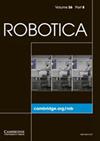Vision-based adaptive LT sliding mode admittance control for collaborative robots with actuator saturation
IF 2.7
4区 计算机科学
Q3 ROBOTICS
引用次数: 0
Abstract
In this paper, we propose a novel vision-based adaptive leakage-type (LT) sliding mode admittance control for actuator-constrained collaborative robots to realize the synchronous control of the precise path following and compliant interaction force. Firstly, we develop a vision-admittance-based model to couple the visual feedback and force sensing in the image feature space so that a reference image feature trajectory can be obtained concerning the contact force command and predefined trajectory. Secondly, considering the system uncertainty, external disturbance, and torque constraints of collaborative robots in reality, we propose an adaptive sliding mode controller in the image feature space to perform precise trajectory tracking. This controller employs a leakage-type (LT) adaptive control law to reduce the side effects of system uncertainties without knowing the upper bound of system uncertainties. Moreover, an auxiliary dynamic is considered in this controller to overcome the joint torque constraints. Finally, we prove the convergence of the tracking error with the Lyapunov stability analysis and operate various semi-physical simulations compared to the conventional adaptive sliding mode and parallel vision/force controller to demonstrate the efficacy of the proposed controller. The simulation results show that compared with the controller mentioned above, the path following accuracy and interaction force control precision of the proposed controller increased by 50% and achieved faster convergence.基于视觉的自适应 LT 滑动模式导纳控制,用于执行器饱和的协作机器人
本文针对执行器受限的协作机器人,提出了一种新颖的基于视觉的自适应泄漏型(LT)滑模导纳控制,以实现精确路径跟随和顺应交互力的同步控制。首先,我们建立了一个基于视觉导纳的模型,将视觉反馈与图像特征空间中的力感应耦合起来,从而获得关于接触力指令和预定轨迹的参考图像特征轨迹。其次,考虑到现实中协作机器人的系统不确定性、外部干扰和扭矩约束,我们提出了一种图像特征空间中的自适应滑模控制器,以实现精确的轨迹跟踪。该控制器采用泄漏型(LT)自适应控制法则,在不知道系统不确定性上限的情况下减少系统不确定性的副作用。此外,该控制器还考虑了辅助动态,以克服关节扭矩约束。最后,我们利用 Lyapunov 稳定性分析证明了跟踪误差的收敛性,并与传统的自适应滑动模式和并行视觉/力控制器进行了各种半物理仿真,以证明所提控制器的功效。仿真结果表明,与上述控制器相比,拟议控制器的路径跟踪精度和交互力控制精度提高了 50%,并实现了更快的收敛。
本文章由计算机程序翻译,如有差异,请以英文原文为准。
求助全文
约1分钟内获得全文
求助全文
来源期刊

Robotica
工程技术-机器人学
CiteScore
4.50
自引率
22.20%
发文量
181
审稿时长
9.9 months
期刊介绍:
Robotica is a forum for the multidisciplinary subject of robotics and encourages developments, applications and research in this important field of automation and robotics with regard to industry, health, education and economic and social aspects of relevance. Coverage includes activities in hostile environments, applications in the service and manufacturing industries, biological robotics, dynamics and kinematics involved in robot design and uses, on-line robots, robot task planning, rehabilitation robotics, sensory perception, software in the widest sense, particularly in respect of programming languages and links with CAD/CAM systems, telerobotics and various other areas. In addition, interest is focused on various Artificial Intelligence topics of theoretical and practical interest.
 求助内容:
求助内容: 应助结果提醒方式:
应助结果提醒方式:


